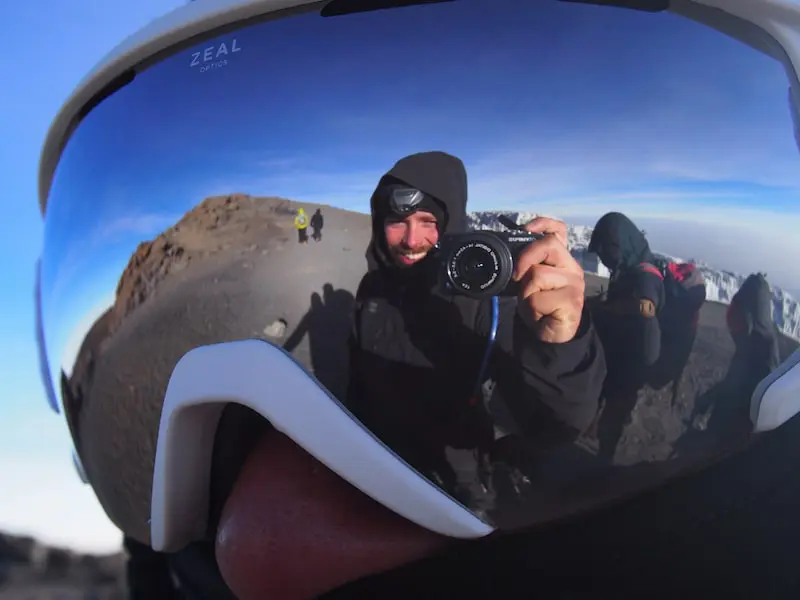Hiking to the summit of Mount Kilimanjaro is not for the faint of heart but is totally doable. Over 7 days, we’ll trek 70km/43 mi, with a total of 4,000m/13,000ft in elevation gain and the ultimate goal of reaching Uhuru Peak at a daunting 5,895m/19,340ft above sea level. We are proud to have a 100% success rate – and nothing will contribute to a successful adventure more than preparation. Read on for our tips to tackle Africa’s highest peak on our Kilimanjaro Gay Climb.
To put things into perspective, you’ll:
- Carry a 5-6kg/11-13lb day pack that will hold what you need each day for up to 6-7 hours (water, sunscreen, layers, waterproof outerwear, snacks, camera, etc.). Porters will carry the rest of your luggage along with tents, food and cooking equipment.
- Trek 10km/6mi + per day as you approach base camp
- Have a 12+ hour final push to the summit and subsequent descent on summit day
- Use core strength and flexibility to navigate uneven terrain
Ideally, you should give yourself at least 4 months to prepare. This can be achieved in a shorter time frame, but training while the clock is ticking can be frustrating and might lead to injury. Below is our guide for getting those glutes, quads, calves and core prepared for this epic adventure.
Aerobic Exercise
Aerobic/cardio training will be a key factor in allowing you to successfully summit Mount Kilimanjaro. Aerobic literally means ‘requiring free oxygen’ and refers to the use of oxygen to adequately meet energy demands during exercise via aerobic metabolism. Aerobic exercise, unlike anaerobic exercise, requires oxygen for elongated periods of time. Thirty minutes to an hour of jogging, cycling, climbing stairs, swimming or even just brisk walking are all good aerobic exercises. Aim to exercise at 70% of your maximum heart rate for the best results.
Leg and core strengthening
Go to any gym, and you’ll come across plenty of contraptions designed to increase the strength of your calves, thighs, hamstrings, glutes and core. The usual warnings apply: always read the instructions carefully before using any machine, and don’t be too ambitious or overload the machine with too much weight, as this could lead to serious injury and the cancellation of your trek altogether.
If you don’t have access to gym equipment, don’t worry: there are exercises that you can do without the need for machines. Load up a day pack with 15-30lbs of weight and make lunges, reverse lunges, calf raises, and squats. For your core, there are a number of exercises you can do without equipment, such as the good old-fashioned crunch. For instructional videos, youtube is a great resource, and this video by REI should help.
We think it helps to concentrate on aerobic exercises three days a week, alternating each day with legs & core strengthening exercises – then rest on the seventh day.
Do a few dry runs
The best training for a trek on Kilimanjaro is to lace up your hiking boots and cover some ground. Your training program should mimic the physical and technical demands of your trekking objective, so it’s best to start with 2-3 hours of walking and work your way up to a full 5-6 hour day, then back-to-back full days (around 10km each), including hills.
Practice makes perfect, and the more you hike leading up to your trip, the more you’ll understand the stress your joints & muscles will be put under and how your body will react. It will also allow you to wear your boots and gear, which can take time, but will ensure you’re as comfortable as possible on the trip.
Psych yourself up
After months of training, take stock of your accomplishments and admire that body-ody-ody, Henny! Read through Tanzania: Kilimanjaro Gay Climb itinerary a few more times and make sure your biggest and sexiest organ (your brain) is prepared for this epic trek. Being physically and mentally prepared will lead to much better odds of a successful summit.
Featured Posts
Scroll through Jeb and Marks' amazing photos below to better understand why Out Adventures has been hosting The Inca Trail & Machu Picchu tour for ten years. Read More
In the interest of preserving Machu Picchu, local Peruvian Authorities enacted new regulations that control the number of visitors to the site and how they explore the ruins. Read More
Six tips to best prepare for Out Adventures gay trek to Everest Base Camp, Nepal. Read More
A fantastic photo series featuring Out Adventures' epic gay hike towards Everest Base Camp. Read More
Based on the feedback of past gay Everest explorers, here are the top ten things they wish they had known before hitting the Himalayas. Read More
